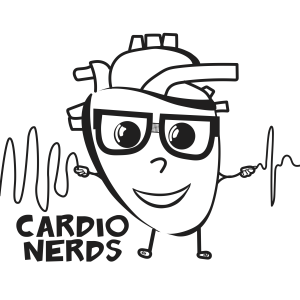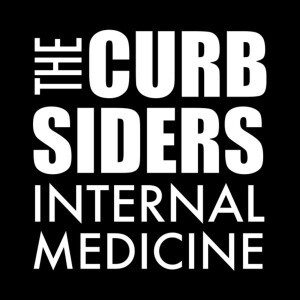

425. Case Report: The Hidden Culprit – Unraveling the Cause of Malignant Ventricular Arrhythmias in a Young Adult – Trinity Health Livonia Hospital
CardioNerds guest host Dr. Colin Blumenthal joins Dr. Juma Bin Firos and Dr. Aishwarya Verma from the Trinity Health Livonia Hospital to discuss a fascinating case involving malignant ventricular arrhythmias. Expert commentary is provided by Dr. Mohammad-Ali Jazayeri. Audio editing for this episode was performed by CardioNerds Intern,Julia Marques Fernandes.
This case explores the puzzling presentation of exercise-induced ventricular tachycardia in a young, otherwise healthy male who suffered recurrent out-of-hospital cardiac arrests. With no traditional risk factors and an unremarkable ischemic workup, the challenge lay in uncovering the underlying cause of his malignant arrhythmias. Electrophysiology studies and advanced imaging played a pivotal role in systematically narrowing the differentials, revealing an unexpected arrhythmogenic substrate. This episode delves into the diagnostic dilemma, the role of EP testing, and the critical decision-making surrounding ICD placement in a patient with a concealed but life-threatening condition.
“To study the phenomena of disease without books is to sail an uncharted sea, while to study books without patients is not to go to sea at all.” – Sir William Osler. CardioNerds thank the patients and their loved ones whose stories teach us the Art of Medicine and support our Mission to Democratize Cardiovascular Medicine.
Enjoy this Circulation 2022 Paths to Discovery article to learn about the CardioNerds story, mission, and values.
US Cardiology Review is now the official journal of CardioNerds! Submit your manuscript here.
CardioNerds Case Reports Page
CardioNerds Episode Page
CardioNerds Academy
Cardionerds Healy Honor Roll
CardioNerds Journal Club
Subscribe to The Heartbeat Newsletter!
Check out CardioNerds SWAG!
Become a CardioNerds Patron!
This case highlights the challenges and importance of diagnosing and managing ventricular arrhythmias in young, seemingly healthy individuals. Here are five key takeaways from the episode:
- Electrophysiology (EP) studies play a crucial role in identifying arrhythmogenic substrates in patients with exercise-induced ventricular tachycardia (VT) without obvious structural heart disease. In this case, substrate mapping revealed late abnormal ventricular afterdepolarizations in the basal inferior left ventricle, providing valuable insights into the underlying mechanism.
- Cardiac MRI can be a powerful tool for detecting subtle myocardial abnormalities. The subepicardial late gadolinium enhancement (LGE) in the lateral and inferior LV walls suggested an underlying myocardial process, even when other imaging modalities appeared normal.
- The VT morphology can provide clues about the underlying mechanism. In this case, the right bundle branch block pattern with a northwest axis and shifting exit sites pointed towards a scar-mediated mechanism rather than a channelopathy or idiopathic VT.
- Implantable cardioverter-defibrillator (ICD) placement is crucial for secondary prevention of sudden cardiac death (SCD) in patients with malignant ventricular arrhythmias, even in young individuals. The patient’s initial deferral of ICD implantation highlights the importance of shared decision-making and patient education in these complex cases.
- “Scar-mediated VT introduces the risk of new arrhythmogenic substrates over time, reinforcing the need for ICD therapy even when catheter ablation is considered.” This pearl emphasizes the dynamic nature of the arrhythmogenic substrate and the importance of long-term risk mitigation strategies.
Notes were drafted by Juma Bin Firos.
1. What underlying pathologies cause ventricular arrhythmias in young patients without overt structural heart disease?Myocardial fibrosis:
- Detected via late gadolinium enhancement (LGE) on cardiac MRI
- Present in 38% of nonischemic cardiomyopathy cases
- Increases sudden cardiac death (SCD) risk 5-fold
- Often localized to subepicardial regions, particularly in the inferolateral left ventricle (LV)
- May precede overt systolic dysfunction by years
Subclinical cardiomyopathy:
- 67% of young VT patients show subtle cardiac dysfunction
- Suggests VT may be the first manifestation of cardiomyopathy
- Can include early-stage genetic cardiomyopathies (e.g., ARVC, LMNA mutations)
- Often associated with preserved ejection fraction (EF >50%)
Arrhythmogenic substrate:
- EP studies localize re-entry circuits to specific regions:
- Basal inferior LV near the mitral annulus (as in this case)
- Right ventricular outflow tract (RVOT) in idiopathic VT
- Papillary muscles or fascicular regions
- Substrate can exist even with normal EF and no visible structural abnormalities on echocardiography
Channelopathies:
- Long QT syndrome (LQTS): QTc >460ms in males, >470ms in females
- Brugada syndrome: Coved ST elevation in V1-V3
- Catecholaminergic polymorphic VT (CPVT): Normal resting ECG, bidirectional VT with exercise
- Short QT syndrome: QTc
More Episodes
All Episodes>>You may also like
Create Your Podcast In Minutes
- Full-featured podcast site
- Unlimited storage and bandwidth
- Comprehensive podcast stats
- Distribute to Apple Podcasts, Spotify, and more
- Make money with your podcast











